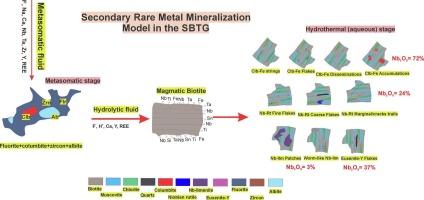Secondary rare metal enrichment following biotite alteration in the Umm Naggat granitic pluton, Central Eastern Desert, Egypt
IF 2.5
2区 地球科学
Q2 GEOCHEMISTRY & GEOPHYSICS
引用次数: 0
Abstract
Biotite is an essential mineral in regulating Nb![]() Ta fractionation during magma evolution. Post-magmatic, metasomatic biotite alteration may form secondary rare metal (RM)-bearing phases. Nevertheless, the mechanism of biotite alteration remains incompletely elucidated. The Umm Naggat granitic pluton (UMNG) in Egypt comprises RM-bearing amphibole-biotite granite (SBTG) in its southern sector, with biotite being significantly more abundant than amphibole. Amphibole and biotite in the SBTG crystallized from Nb-enriched magma and represent primary high-field strength elements (HFSE) reservoirs. Amphibole contains Nb (280 ppm), Ti (5760 ppm), Y (506 ppm), Zr (87 ppm), and Mn (2801 ppm), while biotite contains significantly higher Nb (1630 ppm), Ta (83 ppm), Sn (392 ppm), Ti (9268 ppm), Rb (2846 ppm), and Li (6331 ppm). The Nb enrichment in biotite mainly depended on its composition (Ti and Fe), enhanced by high formation temperatures.
Ta fractionation during magma evolution. Post-magmatic, metasomatic biotite alteration may form secondary rare metal (RM)-bearing phases. Nevertheless, the mechanism of biotite alteration remains incompletely elucidated. The Umm Naggat granitic pluton (UMNG) in Egypt comprises RM-bearing amphibole-biotite granite (SBTG) in its southern sector, with biotite being significantly more abundant than amphibole. Amphibole and biotite in the SBTG crystallized from Nb-enriched magma and represent primary high-field strength elements (HFSE) reservoirs. Amphibole contains Nb (280 ppm), Ti (5760 ppm), Y (506 ppm), Zr (87 ppm), and Mn (2801 ppm), while biotite contains significantly higher Nb (1630 ppm), Ta (83 ppm), Sn (392 ppm), Ti (9268 ppm), Rb (2846 ppm), and Li (6331 ppm). The Nb enrichment in biotite mainly depended on its composition (Ti and Fe), enhanced by high formation temperatures.
In the SBTG, hydrothermal alteration is divided into the metasomatic and aqueous stages. The metasomatic fluid was enriched in Na-F-Nb-Ta-Zr, causing albitization and precipitation of metasomatic fluorite, columbite-(Fe), and zircon. Biotite is extensively altered during the aqueous stage, mainly to muscovite and chlorite, through a coupled dissolution-precipitation mechanism. The replacement textures of primary biotite imply that the hydrothermal fluids were acidic and fluorine-bearing, with considerable Y and REE amounts. During the alteration, Ti, Fe, Sn, Ta, and Nb were liberated from the biotite into the fluid as Ta-Nb-F complexes. The continuous consumption of H+ and F− resulted in their depletion, making the Ta-Nb-F complexes unstable, reducing their solubility, and leading to the precipitation of secondary Ta-Nb-Sn-Y-REE-Fe-Ti-bearing oxides near or within muscovite and chlorite. The former alteration-precipitated oxides, including niobian rutile, Nb-ilmenite, columbite-(Fe), and euxenite-(Y), are significantly enriched in Nb, Ta, and Sn compared to their primary equivalents (primary niobian rutile, Nb-ilmenite, columbite-(Fe), and fergusonite-(Y)). The spatial distribution of biotite alteration byproducts within the SBTG reveals distinct variations where the northern sector of the SBTG includes muscovite, niobian rutile, columbite-(Fe), and euxenite-(Y), while the southern sector includes muscovite, chlorite, niobian rutile, columbite-(Fe), and Nb-ilmenite with the dominancy of Fe cations in the fluid increasing over Ti cations toward the south. The hydrothermal fluid likely evolved into a more acidic character as the fluid temperature dropped with the alteration advancing toward the south of the SBTG. Considering its distinctive petrography, mineralogy, and textural variations, the alteration-formed Nb-Ta-Sn-enriched mineralization may delineate a new potential style and source for RMs in Egypt and worldwide.

埃及中东部沙漠乌姆纳格特花岗岩体黑云母蚀变后次生稀有金属富集
黑云母是岩浆演化过程中调控NbTa分馏的重要矿物。岩浆期后,交代黑云母蚀变可形成次生含稀有金属(RM)相。然而,黑云母蚀变的机理尚未完全阐明。埃及乌姆纳格特花岗质岩体(UMNG)南段由含镁角闪-黑云母花岗岩(SBTG)组成,其中黑云母明显多于角闪孔。SBTG中的角闪孔和黑云母由富铌岩浆结晶而成,是原生高场强元素(HFSE)储层。闪孔含Nb (280 ppm)、Ti (5760 ppm)、Y (506 ppm)、Zr (87 ppm)和Mn (2801 ppm),黑云母含Nb (1630 ppm)、Ta (83 ppm)、Sn (392 ppm)、Ti (9268 ppm)、Rb (2846 ppm)和Li (6331 ppm)。黑云母中铌的富集主要取决于其组成(Ti和Fe),并受高温的影响。在SBTG中,热液蚀变分为交代阶段和水相阶段。交代流体富集Na-F-Nb-Ta-Zr,导致交代萤石、柱长石-(Fe)和锆石的钠长石化和沉淀。在水相阶段,黑云母通过溶蚀-沉淀耦合机制被广泛蚀变,主要为白云母和绿泥石。原生黑云母的替代结构表明热液为酸性含氟流体,含有大量的Y和REE。蚀变过程中,Ti、Fe、Sn、Ta和Nb以Ta-Nb- f配合物的形式从黑云母中析出。H+和F−的持续消耗导致其耗损,使Ta-Nb-F配合物不稳定,溶解度降低,导致在白云母和绿泥石附近或内部析出含ta - nb - sn - y - ree - fe - ti的次级氧化物。前者蚀变沉淀氧化物,包括铌金红石、铌钛铁矿、柱长石-(Fe)和永长石-(Y),与它们的原生当量(原生铌金红石、铌钛铁矿、柱长石-(Fe)和褐长石-(Y))相比,显著富集Nb、Ta和Sn。黑云母蚀变副产物的空间分布表现出明显的差异,北段为白云母、铌金红石、柱长石-(Fe)和永长石-(Y),南段为白云母、绿泥石、铌金红石、柱长石-(Fe)和铌钛矿,流体中Fe离子占主导地位,向南逐渐增加,Ti离子占主导地位。随着蚀变向南推进,热液温度下降,热液的酸性特征可能进一步增强。考虑到其独特的岩石学、矿物学和结构变化,蚀变形成的nb - ta - sn富集矿化可能为埃及和世界范围内的稀土矿描绘了一种新的潜在类型和来源。
本文章由计算机程序翻译,如有差异,请以英文原文为准。
求助全文
约1分钟内获得全文
求助全文
来源期刊

Lithos
地学-地球化学与地球物理
CiteScore
6.80
自引率
11.40%
发文量
286
审稿时长
3.5 months
期刊介绍:
Lithos publishes original research papers on the petrology, geochemistry and petrogenesis of igneous and metamorphic rocks. Papers on mineralogy/mineral physics related to petrology and petrogenetic problems are also welcomed.
 求助内容:
求助内容: 应助结果提醒方式:
应助结果提醒方式:


